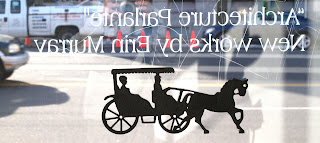Erin Murray: Architecture Parlante
Show Statement
The term architecture parlante ("speaking architecture") refers to the concept of buildings that explain their own function or identity. This can be anything from a statehouse with a patriotic inscription to an oddball commercial enterprise like the famous Brown Derby restaurant, shaped as its namesake. Here, common communication trumps the conceits of Modernism and its Miesian dissection of space, and symbolism is heartily embraced.
While not all of the structures in my work are as overtly parlante as say, a banana stand shaped like a banana, they are "speaking" in the sense that they can convey much about themselves, whether intentionally or not. In a way they are perfectly Postmodern without the benefit of being architect designed: unashamedly embellished and not without a sense of humor. It is this sense of architectural absurdity that I am exploring with the work in this show.
Learning From Harbison Avenue (2011) depicts a stretch of road in Northeast Philly near where I grew up. The houses are small and as simple as shoeboxes but cheerfully trimmed with awnings, fences and shutters of various design. To me they are endearingly absurd, my favorite type of building. The title references Robert Venturi's book Learning From Las Vegas in which he extols the virtues of commercial strip architecture from an academic's point of view. Not for the first time here I've invoked Venturi's work in titling my own in order to add intellectual "weight" to structures that are normally seen as inconsequential. Indeed, the show title serves much the same function.
Three paintings, Liquor Barn, La Villa, and Ming Kui Restaurant (2010) take commercially embellished buildings out of their context and place them where they ostensibly want to be, and no one's happier for it.
BBillboard and Yokefellow (2010) share this sense of absurdity in a more subtle, lyrical way. Both dwarfed by structures above, they have the patina of buildings designed by time. One is more interesting for the graffiti on its backside then anything on its front, while the other presents us with the modern church, where one need only add a cross and a gothic arch to your wrought iron to invoke a sense of the sacred.
















No comments:
Post a Comment